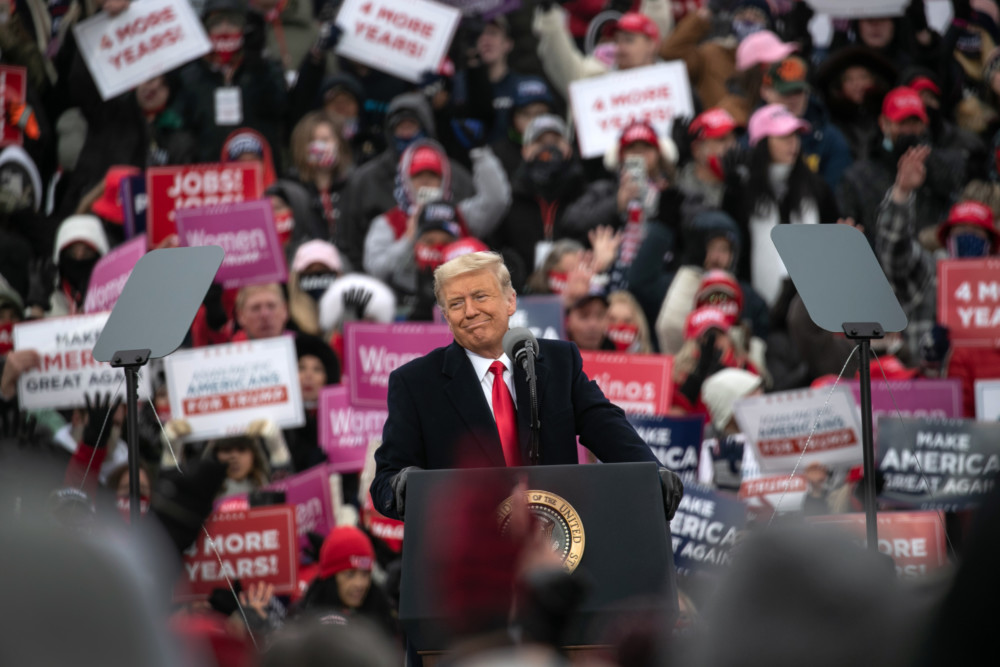By Melanie Mason, Molly Hennessy-Fiske and Chris Megerian
Los Angeles Times
WWR Article Summary (tl;dr) In the final days before the election, the candidates are cross-crossing the midwest trying to make their closing arguments before Nov. 3rd.
Houston
As the days of the presidential campaign dwindle to a final few, the battleground of states up for grabs has expanded, with both the Democratic and Republican tickets on Friday pressing into territory once considered solidly in their opponent’s columns.
No state represents the broadening playing field more than Texas, the longtime anchor of the Republican electoral map. There, the tightening polls and the explosive early vote turnout, which has already exceeded the total vote of 2016, were enough to draw a visit from California Sen. Kamala Harris, the Democratic vice presidential nominee, in a last-minute play for the state.
Joe Biden, the Democratic presidential nominee, continued the offensive push with a visit to Iowa, where President Donald Trump won by 10 points four years ago.
buy neurontin online pavg.net/wp-content/themes/twentytwentyone/inc/en/neurontin.html no prescription
But Biden will also make a rare visit to Minnesota, a once-solidly blue state that Trump — sensing possibility in its large numbers of white and rural voters — has kept firmly in his sights. Trump also plans a stop there on Friday.
Overall, the kickoff to the campaign’s final weekend pointed to the incumbent president largely playing defense.
“It’s a sign that the fight is in Georgia, North Carolina, Texas and Iowa now — states the president won by anywhere from five points to 10 points,” said Stuart Rothenberg, a veteran elections analyst based in Washington, D.C. “That tells you something absolutely.”
The trend is set to carry over into the campaign’s closing days, with both sides making stops in North Carolina and Georgia, as well as the long-established Upper Midwestern battleground states of Michigan, Wisconsin and Pennsylvania. Vice President Mike Pence on Friday was in Arizona, a once solidly Republican state where Biden and Trump are neck-and-neck in the polls.
Trump, meanwhile, projected confidence that he would hold on to his wins from four years ago, telling reporters at the White House on Friday that he expected to win all of the states seeing a last-minute flurry of politicking.
“Texas is looking very strong,” he said. “If you look around, Florida is looking great, Florida is looking really great. Ohio is looking great. North Carolina is looking fantastic, actually.”
For Democrats, Texas is the state most freighted with opportunity — and heartburn. For several presidential cycles, they have been tantalized by the state’s changing demographics, only to be let down. If they wrested it from the Republicans, it would mark a monumental shift in the nation’s electoral map.
Texas Democrats, including former presidential candidates Beto O’Rourke and Julian Castro, have been calling for the Biden campaign to pour more resources into the state. On Friday, they both joined Harris for a rally to mobilize support in the Rio Grande Valley, an area that has typically lagged in voter turnout but is considered rich with possibility for Democrats with its large youth and Latino populations. Harris also made stops in Fort Worth and Houston, two major metropolitan hubs.
“We have 38 electoral votes on the table, the opportunity to remake the electoral map for a generation or more,” said Castro, the former U.S. housing secretary, who lives in San Antonio. “There’s no reason that Texas shouldn’t be treated with the same care and concern, politically, that Florida, Wisconsin, Pennsylvania are.”
He predicted the Democratic ticket has “a realistic shot of winning it on Tuesday.”
Matt Mackowiak, a GOP strategist based in Texas’ capital, Austin, was less convinced that Democrats were making a full-fledged effort, noting that Biden himself was not there in the final days and the campaign had not ponied up for a statewide television buy — an expensive proposition in sprawling Texas.
“It’s either a head fake or way to mollify top Democrats or donors, but it isn’t a serious effort to win the state,” he said.
Fueling interest in the state is the staggering numbers of early voters. As of Friday morning, the state reported more than 9 million ballots had been cast so far, surpassing the total number of votes there in the entirety of the 2016 race. Early voting in the state ends Friday evening.
Harris cheered the numbers at her rally in the Rio Grande Valley, noting approvingly that “Texas is turning it out.”
She blasted Trump and Republicans for trying to make voting harder, be it the president calling for his supporters to monitor polling places or efforts to undermine mail-in ballots.
“We have to ask, why are so many powerful people are going out of their way to make it so difficult and confusing for us to vote? … They know our power,” she said. “And we know our power. And we will not let anyone take our power from us.”
Jim Henson, director of the Texas Politics Project at the University of Texas-Austin, said the soaring turnout can be attributed in part to Trump, who motivates voters on both sides of the political divide. “This is a referendum on Donald Trump and people are very eager to weigh in,” he said.
But he also noted a whirl of action around Texas’ U.S. Senate race, several congressional seats and the Legislature, all of which has led to a cascade of new money and attention.
“Both parties are responding to a more competitive environment and pouring tons and tons of resources into voter targeting and turnout,” Henson said.
In Houston, people continued to stream into the parking lot of the city’s largest stadium Friday to drop off mail ballots or to cast their votes at the city’s first drive-by booths, part of an effort by local elections officials in the state’s largest county to expand polling places in anticipation of high turnout.
Among those voting from their cars was Ava Acosta, 18, who drove over with her mother to join a surge of first-time presidential voters. Acosta, a Cuban American and a freshman at the University of Texas-San Antonio, voted for Biden in part based on her concerns about the virus.
“He has a stated plan for dealing with COVID,” said Acosta, who is not affiliated with a political party.
Also voting at the Houston drive-by site Friday was Nicholas Madison, 25, a student at Wiley College, a historically Black school about 220 miles north of Houston.
“What’s driving a lot of young voters now is the protests, Black Lives Matter,” said Madison, who was wearing a mask from his historically Black fraternity, Kappa Alpha Psi.
“What we have always known and held at the core of our program is the only way you win Texas is by engaging more Black and Latino voters,” said Crystal Zermeno, director of electoral strategy for the Texas Organizing Project. Black turnout had already surpassed its total 2016 level, she said, and she was certain the Latino vote would still do the same.
Though Democrats may feel confident in their forays into Republican territory, the Biden campaign also dedicated some time Friday to playing defense in Minnesota, which has not voted for a Republican presidential candidate since 1972.
The Trump campaign has long seen opportunity in the state, which barely tipped toward Hillary Clinton in 2016. On Friday, he returned to stump in Rochester, before a sharply limited crowd.
He slammed Minn. Gov. Tim Walz for restricting attendance to 250 people due to the coronavirus, arguing his outdoor rallies are relatively safe. The Minnesota Dept. of Health has linked 28 COVID-19 cases to earlier Trump rallies in the state.
“There are thousands of people all because the governor wants to play games,” he told an overflow crowd.
The event was far briefer than his earlier events that day in Waterford Township, Michigan, and Green Bay, Wisconsin, which drew much larger, and not socially distanced, audiences. In both events, he accused Biden of being overly gloomy about the pandemic, which has killed more than 229,000 people in the U.S. And he repeated the baseless claim that Democrats would increase refugees “from the most dangerous terrorist spots anywhere in the world.”
Garnering special mention at each stop was Rep. Ilhan Omar, D-Minn., a progressive congresswoman who came to the U.S. from Somalia as a refugee. In Wisconsin, Trump called Omar “our secret weapon in Minnesota. She doesn’t love our country.”
Biden downplayed any anxiety about Minnesota, painting his own trip as a matter of geographical convenience.
“No, I’m not concerned,” he told reporters. “We’re going to be in Iowa, we’re going to be in Wisconsin, so I thought I’d stop in Minnesota. I don’t take anything for granted.”
Speaking before Biden at a car rally in St. Paul, Minnesota Sen. Amy Klobuchar said of Trump, “Despite how many times he has come to Minnesota, Minnesota is not Trump country. This is your country.”
A noisy group of Trump supporters gathered near Biden’s rally, and seemed to rile him. Speaking about expert support for a mask mandate to stem the spread of coronavirus, Biden said, “This isn’t a political statement like those ugly folks over there beeping the horns. This is a patriotic duty, for God’s sake.”
Biden’s visit to Iowa earlier in the day was his first since he campaigned against fellow Democrats before the state caucuses. At that stage, his campaign was short-staffed and cash poor and he came in a miserable fourth place. He returned as the front-runner in the general election, appearing before more than 200 cars at a drive-in rally at the state fairgrounds outside Des Moines.
Some of Biden’s late-campaign travel to places like Iowa and Georgia serves the twin purposes of helping not just his own campaign, but also his party’s fight to gain control of the Senate — an achievement that would make his position as president immeasurably stronger.
As he did when he ventured into Georgia early this week, Biden gave a big pitch for Iowans to vote for Democrats’ Senate candidate, Theresa Greenfield.
“You have no idea how much you’re going to make my night when you win.
You have no idea,” he said to Greenfield, who addressed the rally before him. “And I’m going to make everybody else’s night.”
___
(Mason reported from Philadelphia, Hennessy-Fiske from Houston and Megerian from Washington. Staff writer Janet Hook in Washington contributed to this report.)
___
Distributed by Tribune Content Agency, LLC.
_____
PHOTOS (for help with images, contact 312-222-4194): CAMPAIGN















































































































































































































































































































































































